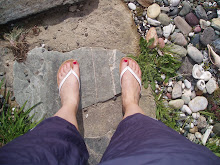Condition 1: Osteoporosis
Final due: 5th June, Peer assessment: 19th June 2009.
Description:
Osteoporosis is defined as a systemic skeletal condition in which the bone tissue deteriorates faster than it is being formed, leading to thinning and weakness of bones. It is not possible to cure osteoporosis (Laroche, 2008), which is an irreversable, degenerative disease of the bone. According to Nevitt (1994), prevention is the best form of cure, as the loss of bone strength that occurs as a result of the loss of bone tissue is permanent. The risk is greatly increased in the elderly due to the slowed production of bone and the heightened possibility of falling and therefore fracturing bones. The best prevention is to build up stronger bones during childhood/adolescence when metabolism is at its peak, in order to reduce the likelihood of osteoporosis occurring later in life.
Etiology:
Osteoporosis is a standard part of the ageing process, and can occur as a secondary condition alongside other systemic diseases and endocrine disorders such as hyperthyroidism and diabetes (Sweet, Sweet, Jeremiah & Galazka, 2009).
It is characterised by loss of bone density and greater fragility of bone tissue, which is exacerbated by various etiological factors, such as a family history of osteoporosis, regular smoking and alcohol consumption and insufficient sun exposure, resulting in low vitamin D levels (Morgan & Kitchin, 2008). A diet low in calcium, certain medications (e.g. glucocorticoids) and low oestrogen levels also increase the likelihood of this disease (Sweet et al, 2009).
In women, the onset of osteoporosis appears most commonly after menopause, in anorexics, and otherwise hormonally or nutritionally deficient individuals (Morgan & Kitchin, 2008).
Signs & Symptoms:
According to Premkumar (1999) bone pain and stress fractures may be present in the initial stages but as the progression is so subtle, the condition may go unnoticed until the event of a fracture, by which time the disease is in its advanced stage and acute damage has occurred. As osteoporosis is a subtle condition that gradually appears during the later stages of the client's life, there is no way of identifying the exact date of initial bone deterioration, and due to its irreversable nature it may require the remainder of the client's life to reach the peak of its expression. Loss of height and bone deformities such as kyphosis of the spine can indicate that the acute stages of the disease are present in the spinal bones (Holt, 2008).
Morphology:
A deficiency in the minerals that form bone tissue, particularly calcium and phosphate, can force the body to extract these from the bones in an effort to achieve homeostasis. This leads to accelerated osteoclastic resorption (Laroche, 2008) which results in the bone tissue presenting as demineralised, brittle and fragile, breaking easily with little stress (Premkumar, 1999).
Incidence:
1.3 million bone fractures per annum in the overall population have been caused by osteoporosis in the United States (Cooper, 1999). Within this population, 1 in 8 men will suffer from an osteoporotic fracture in their lifetime as will 1 in 2 white women (Sweet et al, 2009).
Indications for MT:Exercise, gentle massage particularly excercising caution over bones and bone structures, light to medium massage pressure over stiff neighbouring muscles using the fingertips in a circular motion or alternatively, the palm of the hand (Salvo, 2008).
Contraindications for MT:
Deeper massage over bones and greater stroke pressure. Deep tissue massage techniques near the site of osteoporotic bone are also contraindicated as these may aggravate the progression of bone fractures and so must only be used with necessary caution by a qualified practitioner (Leidig-Bruckner et al, 1997).
References:
Boschert, S. (2002) Risk Factors Don't Always Predict Osteoporosis. San Francisco: Internal Medicine News. Retrieved on the 16th May, 2009 from: http://www.internalmedicinenews.com//article/PIIS109786900271086X/fulltext
Cooper, C. (1999) Epidemiology of Osteoporosis. Southampton: Osteoporosis International. Retrieved on the 16th May, 2009 from: http://www.springerlink.com/content/865w7gj0t4496n1p/fulltext.pdf?page=1
Holt, E. (2008) Osteoporosis. Retrieved on the 16th May, 2009 from: http://www.nlm.nih.gov/medlineplus/ency/article/000360.htm
Laroche, M. (2008) Treatment of Osteoporosis: All the Questions We Still Cannot Answer. The American Journal of Medicine, 121 (9), p. 746.
Leidig-Bruckner, G., Minne, H., Schlaich, C., Wagner, G., Scheidt-Nave, C., Bruckner, T., Gebest, H. et al. (1997) Clinical Grading of Spinal Osteoporosis: Quality of Life Components and Spinal Deformity in Women with Chronic Lower Back Pain and Women with Vertebral Osteoporosis. Journal of Bone and Mineral Research, 12 (4), pp. 663 - 675.
Morgan, S. & Kitchin, B. (2008) Osteoporosis: Handy Tools for Detection, Helpful Tips for Treatment. The Journal of Family Practice, 57 (5), p. 313.
Nevitt, M. (1994) Epidemiology of Osteoporosis. San Francisco: University of California. Retrieved on the 16th May, 2009 from: http://www.ncbi.nlm.nih.gov/pubmed/7984777
Premkumar, K. (1999) Pathology A - Z: A Handbook for Massage Therapists. Calgary: Lippincott Williams & Wilkins.
Salvo, S. (2008) Mosby's Pathology for Massage Therapists. New York: Elsevier Health Sciences, p. 112.
Sweet, M., Sweet, J., Jeremiah, M. & Galazka, S. (2009) Diagnosis and Treatment of Osteoporosis. American Family Physician, 79 (3), p.193 - 200, Table 2.

No comments:
Post a Comment